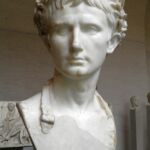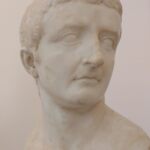Statue of a Roman general in the Palazzo Massimo Alle Terme museum in Rome. The sculpture is dated to the late period of the Republic. It shows an older man with a young, naked body. The man is shown in a heroic pose – this is a style characteristic of Hellenic culture. The object was found in the remains of the Temple of Hercules.
In the town of Gaeta, there is a large mausoleum of Munatius Plancus, where a plaster copy of this statue is exhibited. The description in Gaeta contains information that the original from the Palazzo Massimo Alle Terme Museum is considered by many to represent Munatius Plancus.
Plancus himself is an interesting figure in itself, showing how difficult it was to manoeuvre between different factions in the rapidly changing reality of Rome from the turn of the Republic and Empire.
On the one hand, Plancus was a student of Cicero, which associates him with the optimism faction, on the other – his further career shows his relationship with the opposite camp – Caesar and the popular. He was a participant in the Gallic war, and later in the civil war against Pompey also stood on Caesar’s side. The prize for this attitude was the position of the prefect of Rome, the governorship of Gaul Zaalpejska and the right to triumph. After the assassination of Caesar, he took the side of Mark Antony, who seemed to have the best chance of taking over the political schema of Caesar during the time immediately after the March Ides. He benefited again – he became consul of 42 BCE, which would probably not have been possible without the support of Antony. However, as you can see, he was guided primarily by political realism, because at the time of the final game between Antony and Octavian, Plancus took the side of the latter.
Some interesting facts from Plancus’s life are:
- it was at his request that the senate passed a resolution to give Octavian the title “Augustus”. Certainly, the role of Plancus was only formal here because the adoption of this resolution and its content had been established earlier in the palace of Octavian in the Palatine, but it can be assumed that thanks to him Octavian went down in history under a new name, thus beginning a new period in the history of Rome;
- Plancus left a very lasting souvenir – he left his mark on European history as the founder of the Lugudunum colony – modern Lyon in France.
One of Plancus’s children was a certain Plancina – wife of Calpurnius Piso, a nobleman from the reign of Tiberius. Piso and Plancina were involved in causing the death of Germanicus – the adopted son of Tiberius and his planned successor. The participation of Plancina and Piso in this event is very mysterious and will probably never be explained.







